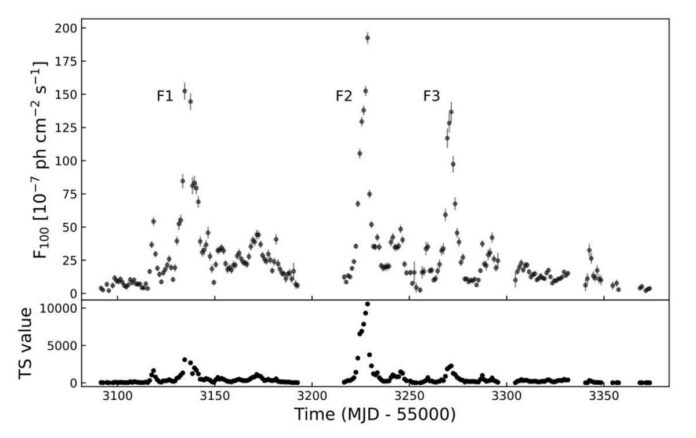Chinese astronomers studied the variability and spectral behavior of gamma-ray flares in a distant blazar known as 3C 279. They used NASA’s Fermi spacecraft to do so. The study’s findings were published in the Publications of the Astronomical Society of the Pacific. The study will help researchers better understand blazar flaring activity.
Blazars are quasars that are very compact and are associated with supermassive black holes at the centres of active and giant elliptical galaxies. Astronomers classify blazars into two types based on their optical emission properties. One is flat-spectrum radio quasars (FSRQs). These have prominent and broad optical emission lines. Another is BL Lacertae objects (BL Lacs). These do not prominent and broad optical emission lines.
3C 279 is an FSRQ at a distance of about 5 billion light years with an estimated black hole mass of 300-800 million solar masses. It is the first blazar to show strong and rapid variability at GeV energies. It is a bright and powerful gamma-ray source in the high-energy sky.
3C 279 has had several outbursts in the last ten years. Three of them occurred in the gamma-ray regime in 2018. These three gamma-ray flares were observed by a team of astronomers led by Gege Wang of Guangzhou University in China. They have used the Fermi’s Large Area Telescope (LAT) for their observation.
Wang’s team was only able to create a detailed minute timescale binned light curve and gamma-ray spectral analysis for the flare F2. Because the flares F1 and F3 lacked notable fast components or profiles. The gamma-ray flux peak in F2 was found to have exceeded the level recorded during previous flaring activity in 2015.
The study discovered that there are no clear breaks in the gamma-ray spectra of 3C 279 in either the flaring or quiescent states. The discovery implies that the blazar’s gamma-ray dissipation region lies outside the broad-line region (BLR). The energy dissipation is caused by the inverse Compton (IC) process of scattering dusty torus infrared photons.
The astronomers calculated the broadband spectral energy distribution (SED) of the flare F2 in “pre-outburst,” “flare” and “post-flare” states. They also calculated the magnetization ratio of the blazar as well as the electron to magnetic field energy density ratio. The findings suggest that the flare F2 was caused by an injection of higher-energy electrons from outside the dissipation blob.

